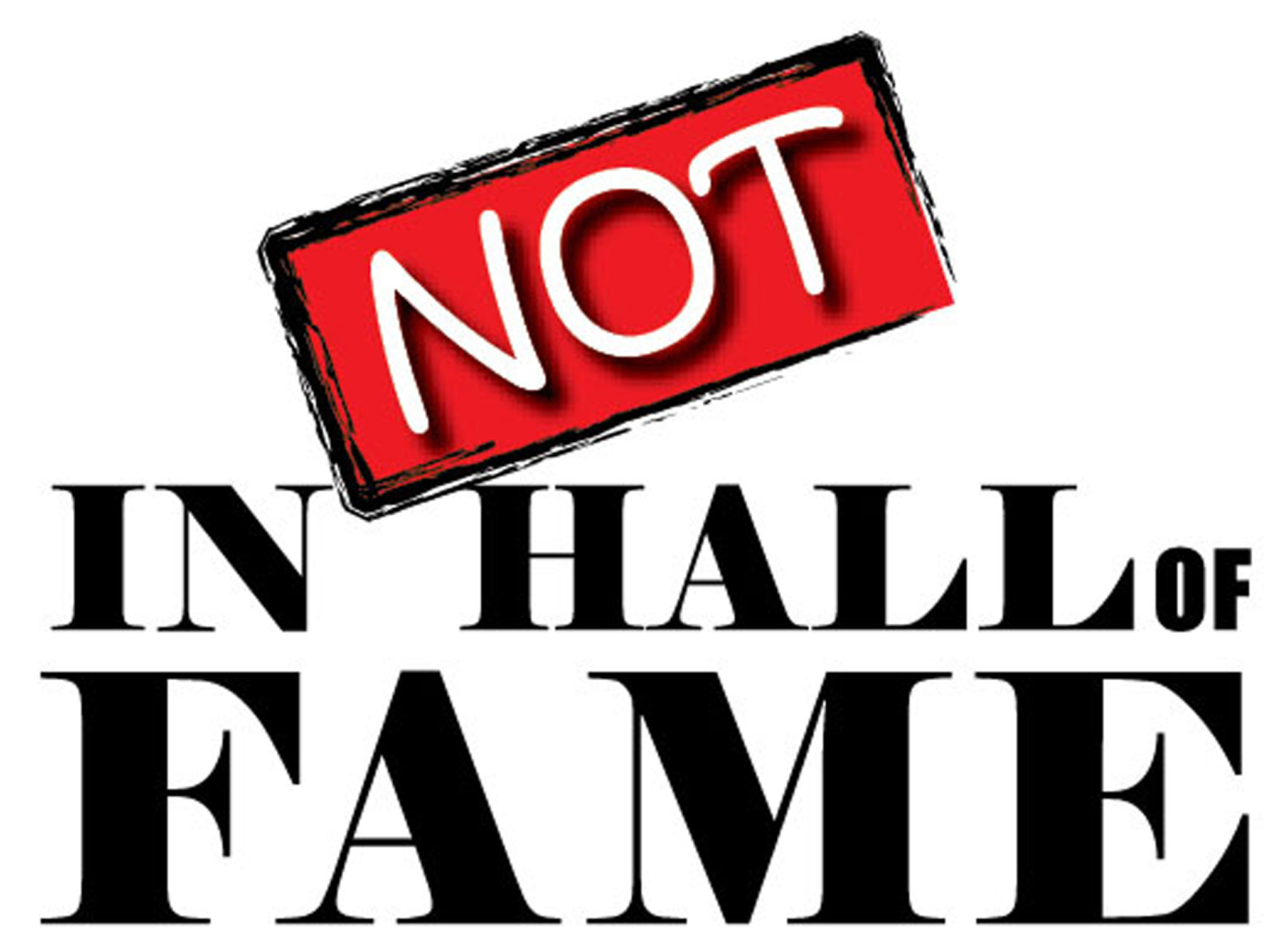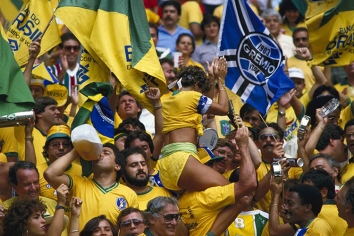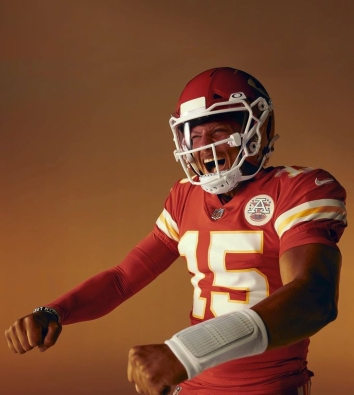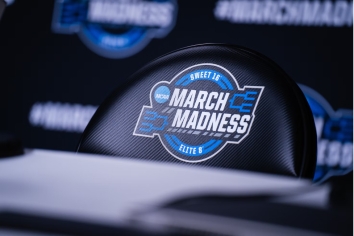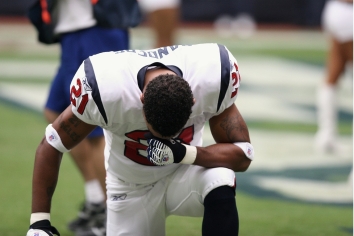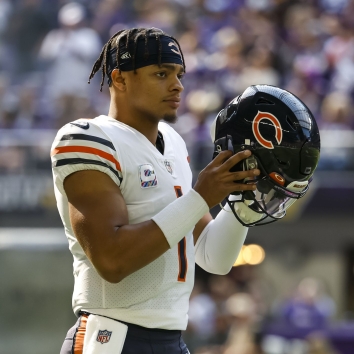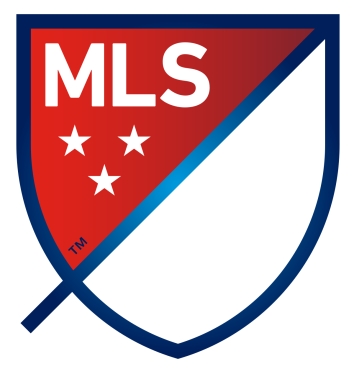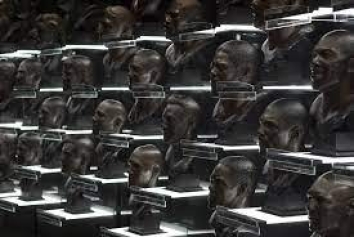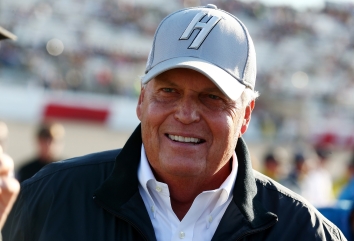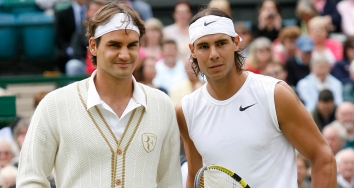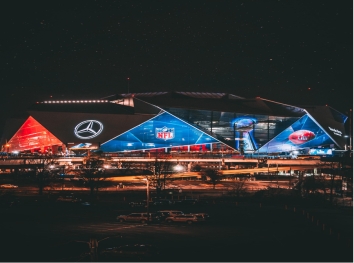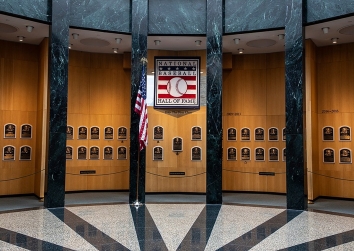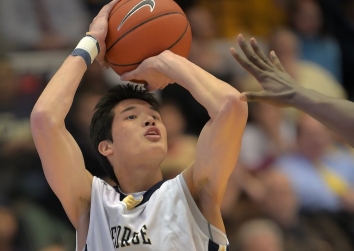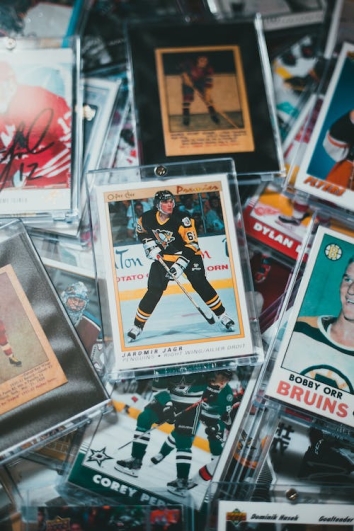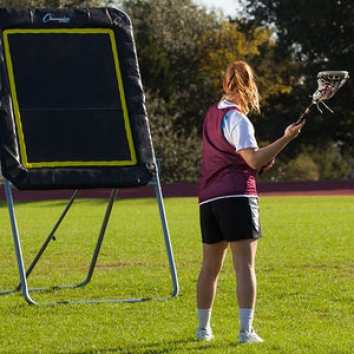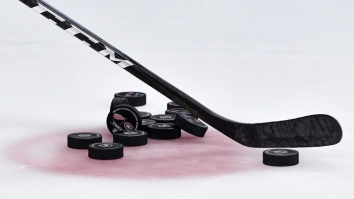From the Desk of the Chairman
4 Vacation Destinations for Sports Fans
Barriers exist between most countries; culture, language, politics, and other blockages create walls that are challenging to climb. But one universal element every nation has in common is sports – and sports break those barriers. Whether participating or watching, sport is a language in itself that appeals to the social, competitive side of humans – and it’s an excellent way to understand, get to know, and enjoy the company of anyone from any country around the world.
Sports becomes an incredible experience when combined with a love of traveling; many people explore other lands and cultures through their passion for their game. With that in mind, these destinations with penchants for sports are perfect itinerary items for sporting fanatics.
United Kingdom
England is famed worldwide for its soccer scene. Across the land, local, national, and even international matches take place like regular clockwork. Plus, the crowds are phenomenal; it’s not uncommon for stadiums to sell out, with fans showing up for games in numbers over 40,000.
Furthermore, cricket is another contender that English folks across the pond go nuts for, as is tennis, especially in the season when London becomes the center of the world’s attention each June – when the iconic Wimbledon championship starts. Among other unmissable sporting events in the UK are Epsom Downs and Ascot horse races (along with the Grand National, too), which turn into highly sophisticated formalwear events and sporting shows. However, when it comes to getting rough and dirty, the rugby league is unmissable – especially when Wales is playing; the team’s camaraderie is second to none.
North America
North America is famed globally for many things – but a robust roster of sports is probably one of the biggest. Some destinations are renowned for one or two particular sports (like the UK and its buzzing soccer culture). All across the United States and Canada, though, all sports are rife – right from kids in elementary school taking part in extra-curricular clubs to college sports teams – and, of course, the major leagues at the professional level.
People go wild in the US and Canada for football, basketball, ice hockey, baseball, and even crazier and more dangerous sports like NASCAR. In fact, many Americans and Canadians make their sport of choice their entire reason for a vacation. Take ice hockey, for example; fans often book tailored NHL travel packages designed to get them in on the hockey action, attend matches, and enjoy a trip away. Many travel operators also offer the same services for fans of other sports and leagues, from the NBA to the NFL.
Japan
Think “baseball”, and the USA immediately springs to mind. Granted, the game was birthed in New York – but the Japanese seem to be the biggest baseball fans in the world. In big cities like Tokyo, tourists can enjoy a unique blend of western and Japanese sporting culture, with sumo wrestling and martial arts representing one flavor and the country’s passion for baseball another.
Rio de Janeiro and Sao Paulo, Brazil
Brazil is the ultimate place for soccer lovers who can’t get enough gorgeous beaches and sports culture simultaneously. Specifically, Sao Paulo and Rio de Janeiro are two top spots for soccer fans; the latter’s home team draws in crowds of over 70,000 at the Macaranã stadium – an atmosphere discerning soccer enthusiasts do not want to miss.
If that’s a little too exciting, sampling the fun street soccer with the locals in Sao Paulo affords an authentic insight into Brazil’s soccer culture at the grassroots level.
Is the AFC filled to the brim with Hall of Fame quarterbacks?
The Hall of Fame promises to be a crowded place for quarterbacks in the AFC in 20 years if the current crop of players continue to astound and develop. The 2022 season has highlighted the rise of brilliant young quarterbacks, so much so that Patrick Mahomes, at the age of 27, is the elder statesman of the group. The Kansas City Chiefs player has already put forward an impressive resume for his Hall of Fame credentials. He's already won one Super Bowl and reached another in the first five years of his career.
The Chiefs are once again backed as one of the leading contenders in the odds to win the Super Bowl. A second Vince Lombardi Trophy would all but ensure that Mahomes will be donning a yellow jacket at the end of his career. However, there will be intense competition along the way due to the quality of quarterbacks and teams in the AFC Conference alone. That will make Canton, Ohio a crowded place should they all opt to retire at the same time. It will also make for an enthralling 20 years of AFC action, bringing back memories of the conference when it was at its best, a time when Tom Brady, Peyton Manning, Philip Rivers, Ben Roethlisberger and others battled it out to reach the Super Bowl.
The new era looks even more exciting.
Patrick Mahomes
Mahomes has almost punched his ticket to Canton and, if he opted to retire tomorrow, there would be few doubters that would deny him a place in the Hall of Fame. He has been electric on the field since replacing Alex Smith in his sophomore season. Mahomes appears to be all set to win his second MVP after a brilliant 2022 season in which he propelled the Chiefs to the number one seed, notably without Tyreek Hill.
That was a major challenge for Mahomes, but he passed with flying colors, connecting with his new wideouts. With Travis Kelce closer to the end of his career than the start, he will have to continue to develop players around him. Mahomes will now aim to reach his third Super Bowl to banish memories of his side’s defeat to the Tampa Bay Buccaneers in the 2020 campaign.
Josh Allen
Allen and Mahomes played out a thrilling Divisional Round matchup last season. Mahomes’ brilliance in the final 13 seconds tied the game before the Buffalo Bills were beaten in overtime to deny them a second-straight AFC Championship appearance. Allen has been incredible once again this season, displaying maturity and leadership as well as having every throw in the book. He alone will give the Bills a fighting chance in the AFC every year.
Even after Tom Brady's exit, it was not easy to dethrone the New England Patriots at the top of the AFC East. But Allen and Buffalo are now kings of the East and will now look to transfer that dominance to the AFC. He and his team just need to raise their levels in the big games, because only then can Allen be considered one of the greats.
Joe Burrow
Burrow well and truly announced his arrival lasts season with a brilliant run to knock off the Chiefs away at the AFC Championship Game. The Bengals were not quite ready to win the Super Bowl, narrowly losing out to the Los Angeles Rams. However, Burrow and his team are a confident bunch and, with Joe Cool as quarterback, will be contenders every year.
Burrow has earned comparisons to Brady when it comes to his demeanor on the field. He always seems to make clutch throws with pinpoint accuracy when it matters the most. Burrow doesn’t have the wow plays of Mahomes and Allen, but he's downright clinical when required. If the Bengals can keep him upright and injury-free, Cincinnati will be a perennial Super Bowl contender.
Burrow has the personality and drive to win multiple crowns. Although he'd be doing very well to ever match Brady, he is certainly capable of winning one or two.
Trevor Lawrence
In the early stages of the 2022 seasons there were fears that Lawrence was trending towards being a bust. He endured a miserable rookie campaign, which was entirely the fault of former head coach Urban Meyer, who failed to last the term with the Jacksonville Jaguars. Doug Pederson’s arrival promised stability and the chance for Lawrence to develop. It didn’t appear to go that way after a poor performance in a loss to the Denver Broncos.
But from then on Lawrence flicked the switch and was sensational down the stretch, guiding his team to seven victories in nine games. The Jags won the AFC South for the first time since 2017 and it could well be the start of an era of dominance. Lawrence’s performances were made all the more impressive considering the lack of talent around him. If the Jags get him some top-tier receivers, he will flourish in Florida.
Justin Herbert
Herbert is the other quarterback in the AFC West that has all the tools, but has not quite put it all together yet. He won Rookie of the Year ahead of Burrow and Tua Tagovailoa in 2020, but he has not been able to take the next step yet, despite making the post-season for the first time in 2022. The Los Angeles Chargers have always had a string of bad luck and bad decision-making that has held them back. They cannot afford to let that happen to Herbert as it did his predecessor Rivers.
Herbert has all the talent in the world and skills to match Mahomes, Allen and Burrow. He just needs to settle in with a composed coach that will allow him to thrive in the big moments. Herbert could be the answer to the Chargers’ longstanding playoff woes.
Tua and Lamar
Lamar Jackson could have been on the same trajectory as the other quarterbacks, but injuries and a lack of post-season form has stalled his progress. Renowned for his running ability, he has developed as a passer, making him a dual-threat quarterback. Until he can resolve his injury woes once and for all, he and the Baltimore Ravens are going nowhere.
It’s the same story for Tua and the Miami Dolphins. After two poor seasons, head coach Mike McDaniel appeared to unlock Tua's potential. Tua connected with Tyreek Hill and Jaylen Waddle to devastating effect to propel Miami towards the number one seed in the AFC. However, he sustained two concussions over the course of the season, the second one ruling him out of the final three games of the campaign. That is a huge concern for the Dolphins moving forward, and could end a bright career.
Which Team Has The Best Odds of Winning March Madness 2023?
It's that time of year again. The NCAA Men's Basketball Tournament is right around the corner, and fans everywhere are wondering which team has the best shot at winning it all. We've got the latest March Madness odds, so read on to see who the experts pick to take home the title in 2023.
Houston
Houston basketball has had a strong season, and all eyes are on them to win the coveted March Madness 2023. With the best odds of victory at +600, it's clear why they are favored to win the tournament. While other teams certainly have excellent players and valuable experience, Houston has demonstrated impressive tenacity and unparalleled skills, which give them an edge in this competition—especially considering their deep understanding of team play.
Their strong defense makes them formidable to any opponent. So as Houston prepares for the big game and against the toughest competition, many experts agree that they have what it takes to take home another championship title for the city.
Kansas
The Kansas basketball team looks like one of the strongest contenders for the championship title this year, with superior odds currently standing at +750. Led by experienced veterans and emerging stars, the team has far exceeded expectations and boasts a roster that gives other teams plenty to worry about.
Team chemistry is clearly on display in every game, and the Kansas statistical powerhouses have consistently outperformed opponents. With such strong form, it's no surprise that fans already anticipate a victory for their beloved team. The stakes are high, and we can only wait in anticipation to see if the championship title will end up coming home to Kansas this season.
Purdue
The Purdue Boilermakers have had some impressive performances so far this season and are quickly emerging as potential contenders to watch. Despite being one of the longest shots on the betting boards with +1200 odds, they boast a solid roster and have already upset several top-tier opponents within the Big Ten Conference.
As they gain confidence and sharpen their skills throughout the remainder of regular season play, don’t be surprised if you start hearing more about the Purdue Boilermakers closer to tip-off!
Arizona
The Arizona Wildcats are certainly making some waves this season, and with their impressive record so far, they’re right up there amongst the top contenders. With odds of +1300 to win the championship this season, they come in at fourth place - a testament to the team’s competitiveness and determination across all positions.
While the competition is tough, this squad has already gone up against some of the nation's most formidable opponents and emerged victorious, so it wouldn’t be too surprising if they continue to make a splash in conference play. Time will tell if these hard-working Cats have what it takes to make a serious run for the title.
Connecticut
Connecticut has a real chance to go all the way at this year’s competition, with odds of +1400 for them to take home the title. Considering its track record, Connecticut stands out as one of the most promising contenders for this championship.
Famous for its impressive lineup of experienced players, a strong coaching staff, and an emphasis on both skill development and team spirit, it's not hard to see why they are in the running. While they will undoubtedly face stiff competition in 2023, Connecticut is certainly one squad you should watch closely throughout their journey.
The Most Shocking NFL Upsets in History
The Most Shocking NFL Upsets in History
Whether you're a football fan or not, we can all agree that the National Football League (NFL) is a huge part of our culture. The Super Bowl has become like a National Holiday. Every year, we look forward to watching the game and seeing who will emerge victorious, even if we have yet to learn much about either team.
Every year, NFL happens, and as always, it had some twists and turns along the way. Of course, the most remarkable games in NFL history resulted in shocking upsets, and we've listed the greatest ones here.
The Dallas Cowboys vs. the San Francisco 49ers (2022)
The playoff rivalry between the San Francisco 49ers and the Dallas Cowboys goes back a long way. Currently, NFL odds have America's Cowboys as the favorites every season, and their 8.51 million fans agree. However, on January 16, 2022, despite a fierce comeback attempt by the Cowboys (11-7), the San Francisco 49ers (11-7) prevailed 23-17 at AT&T Stadium in Arlington, Texas. With their victory, the 49ers became the first road team to advance in the playoffs.
Prescott completes a 20-yard gain on a quarterback sneak in 0:14 seconds, moving the ball to the 49ers' 25-yard line. They need more time as they try to form a lineup. The umpire must touch the ball. He takes out for the middle of the field and promptly loses possession of the ball. The 49ers win by a 23-17 after the center gets the ball to Prescott just as time expires.
The Pittsburgh Steelers vs. the Indianapolis Colts (2005)
In the 2005 AFC Divisional Playoff, the Steelers led the Indianapolis Colts 21-3 in the last quarter. However, the Colts came out strong in the final 15 minutes of the game.
Over 10 minutes, they earned 15 points, cutting the deficit to three points at 21-18 with 4:24 on the clock. The next drive resulted in no points for the Steelers and increased pressure on the defense to hold back Peyton Manning and the Colts' high-scoring attack.
The Steelers appeared to be cruising to an easy AFC Championship Game berth with 1:20 remaining and possession at the two-yard line. However, it was not the case. After receiving the handoff from the two, Jerome Bettis was sacked by Gary Brackett, and the offense recovered the ball. Nick Harper snatched it up and sprinted while the Steelers' sideline gazed in stunned awe. What was a fairly easy finale to the game quickly became a nightmare. All hope seemed lost until Ben Roethlisberger performed what would be forever named "The Tackle." At the Colts' 42-yard line, Roethlisberger made the crucial shoestring tackle on Harper, preventing what seemed like it would have been an easy touchdown.
With 1:01 remaining and the ball on their 42-yard line, the Colts appeared to be in command. Starting at the Steelers' 28-yard line, Manning completed passes of 22 and 8 yards to Reggie Wayne and Marvin Harrison, respectively. Next, kicker Mike Vanderjagt stepped up to make the 46-yard field goal.
The Steelers used a timeout to try to calm him down, but the kick sailed wide. What happened after it is legend or legend itself. The Pittsburgh Steelers prevailed and advanced to the AFC Championship Game, ultimately defeating the Seattle Seahawks in Super Bowl XL.
The New England Patriots vs. the New York Jets (2011)
Any game between the New York Jets and the New England Patriots will garner wide attention. There is more at stake here than a simple border battle between two regions that cannot stand the sight of each other. You can't find a better football rivalry than this.
In 2011, however, the Patriots finished the regular season with a 14-2 record, good enough to secure the AFC's top playoff spot. When the Patriots and Jets last met during the regular season, the Patriots won by a score of 45 to 3. New York won the divisional round game 28-14 thanks to a 20-yard touchdown run from Shonn Greene and five sacks of Tom Brady.
After a drought of more than 40 years, the Jets nearly made it to the Super Bowl before losing to the Pittsburgh Steelers in the AFC Championship Game.
The Miami Dolphins vs. the New England Patriots (2008)
The 2008 Super Bowl champions are the New York Giants. They won the Super Bowl and defeated one of the best teams in history. The final result was 17–14 in favor of the Giants over the Patriots. They were able to pull out the victory thanks to Eli Manning's incredible play in the fourth quarter. He had two touchdown passes in the fourth (both of which gave his team the lead), no interceptions, and completed 9 of 14 passes.
Ultimately, the Patriots' loss came down to them being outperformed. This was demonstrated when Eli escaped a collapsed pocket, and David Tyree intercepted a pass intended for New England safety Rodney Harrison. New England's offensive momentum sometimes picked up, but the Giants' defense eventually stifled the Patriots.
Final Thoughts
Sports fans adore the NFL playoffs for several reasons, including seeing underdogs upset favored teams like the ones we've highlighted here. The history of NFL upsets only proves that each season brings its unique set of unpredictable games, which makes the NFL so exciting to watch.
Are the UK gambling laws more Permissive than other Western Countries?
Different countries have varying gambling laws. For some, gambling is totally prohibited, while in others, bettors have different levels of freedom. In countries where gambling is permitted, the sector has thrived, while in those with stringent regulations, it has lagged. Kate Richardson, a sports betting expert who has been providing insights and tips and exploring different gambling markets, observes that even in countries where wagering is allowed, some aspects are not permitted.
not collide with the authority. In her scrutiny of the gambling laws and the list of online UK bookmakers, Kate observes that UK betting laws are relatively permissive compared to most western countries. She concludes that operators and punters find it easy to engage in gambling activities in the UK than in any other country in the Western sphere. In this article, we focus on UK gambling laws and compare them with regulations in other western countries.
The UK Gambling Commission
Kate Richardson observes that different forms of gambling have enjoyed massive popularity over the years in the United Kingdom. Any person who is over 18 years is eligible for gambling. However, one must gamble on a platform licensed by the gambling authority. The body that is charged with regulating and licensing all gambling activities is the UK Gambling Commission. The regulatory body was founded in 2007. The commission offers licenses to operators and advises the authorities on gambling-related matters. It works together with the police department to curb illegal gambling in the country.
In her review of UK gambling, Kate Richardson states that the commission is not only about licensing and regulating; it also offers guidance to people and businesses interested in offering gambling in the country. It does this by providing the interested parties with information to help establish a successful establishment. She has been instrumental to the sports betting fraternity in the United Kingdom and other jurisdictions. Her insights and tips on sports betting have helped beginners and established bettors. To access her profile and some of the articles she has written on sports betting, click here.
Operators find the UK market easy to penetrate compared to other jurisdictions in Europe and the whole of the western sphere. Analysts observe that the licensing process in the UK is straightforward while also listing the transparency that characterizes the market and the policies and standards that guarantee the player protection.
Any company ready to adhere to the set rules and regulations in the United Kingdom will find it easy to establish its base in the market. For this reason, analysts view the United Kingdom gambling market as welcoming and its laws more permissive than other western countries such as Germany, Australia, Austria, France, Japan, the USA, and Canada, among others. For instance, compared with Austria, UK gambling laws are quite permissive.
Although gambling is allowed in Austria, authorities have stringent online and land-based gambling regulations. For a player looking to wager in such a market, it is advisable to familiarize themself with all the laws governing gambling in the country. Through this, a player can decide on what to venture into, as each gambling platform has its benefits.
France
Like most countries in the western sphere, all forms of gambling in France are highly regulated. For players looking to play in brick-and-mortar platforms, most forms of gambling are available. Online operators are also allowed to offer the same, with the exception of casino games. Generally, France is a gambling-friendly nation, but operators and players are burdened by taxes on their winnings.
- Spain has the Spanish Gambling Act, which regulates all gaming activities in the country. The law stipulates that only regional players can play on licensed platforms.
- Italy, which is home to Baccarat, has a gambling law that regulates sports betting, lotteries, and other games of chance.
- New Zealand does not allow any gambling and betting activities unless they are established in accordance with the NZ Gambling Act 2003. Gambling activities are classified into levels 1-4. Remote gambling remains prohibited in the country.
- The current laws in Canada prohibit all forms of gaming, with the exception of the provincial government, which is allowed to conduct and manage gambling in their jurisdictions.
- Germany only passed a law allowing for partial liberalization of gambling in 2021. The law allows private operators to offer gambling services but to the extent of the licensing and regulatory standards.
- In the United States of America, gambling largely remains legal per federal law, but each state has its own rules and standards.
Although the United Kingdom has similar laws where operators are guided on how to conduct their business, the country has the most permissive gambling regulations.
Bright Spots for a Bears Team Building towards Contending
Entering the very late bye of Week 14, the Chicago Bears sported a humbling 3-10 record. The .231 percentage had Chicago ranked as the lowest team in the NFC, on par with the Denver Broncos, and only below the 1-11 Houston Texans. It’s not great company for a team with a good share of high-quality talents.
Regardless, this was never meant to be the season that the Bears surged towards the playoffs, as the CBS Sports preseason predictions suggest. In the NFC North, the Green Bay Packers were meant to be the top contender, but the Minnesota Vikings bulked up and the Detroit Lions are starting to realize the quality of the players at the team’s disposal.
Even if three wins were to be the final count for the Bears this season, it hasn’t been all bad. The 270 points for coming out of the bye was seven better than the Aaron Rodgers-led Packers, which is always nice. With five games lost by seven or fewer points, some by less than a field goal, the Bears certainly showed up more than the record would suggest.
There have been bright spots dotted around the 2022 season for Chicago, even if the season will end with the 17th game. Importantly, there’s good reason to be optimistic next season, especially once a high draft pick is secured.
Injuries and working out the receiver room
While the Chicago Bears have been able to stay mostly healthy overall, little irritating injuries have popped up at inconvenient times. Justin Fields missing one, Khalil Herbert going down just as he looked set to almost take the backfield for his own, and the double knockout of Bears defensive backs Kyler Gordon and Jaquan Brisker for two games all contributed to a somewhat stop-start feeling around the Bears this season.
Overall, though, the good take is that most key players and up-and-coming stars have been able to play the majority of the games. That said, this makes the receiving space that much more baffling. Darnell Mooney and Cole Kmet have become the main targets for Fields, sharing 111 targets over 13 games, but behind them, it’s anyone’s guess with Equanimeous St. Brown, Dante Pettis, and Chase Claypool seemingly the frontrunners of the other six or so candidates, but is largely ineffective.
Ground game gathering speed
If there’s been one outright shining light for the ’22 Bears, it’s been the run game. Perhaps the only frustrating element has been that Herbert hasn’t been allowed to take full command just yet. David Montgomery hit 641 yards and a 4.0 average through 12 starts. Herbert, in one start and ten games, collected 643 yards and a 6.0 average. To Montgomery’s credit, he’s picked up in the passing game, collecting 25 of 30 targets for a 9.8 average.
Of course, the star of the show has been Fields. Yahoo reports that Fields is hitting the highest yards per carry mark in a single season of any player at 125 carries coming into the bye. Accompanying this, a historic average of 7.1 yards per carry, as well as a franchise-record 67-yard stomp to score a touchdown against the Miami Dolphins.
However, one of the reasons why the receiving corps has been relatively hit-or-miss has been Fields getting hurried – which has also encouraged his absurd rushing figures. At the start of the season, the Bears’ O-line ranked nearly dead last, but legend Olin Kreutz sees flashes of potential from Teven Jenkins, perhaps even enough to one day earn him a Pro Bowl nod.
It’s been very slow going as far as a football season goes, but the starting set of Jenkins, Riley Reiff, Sam Mustipher, Cody Whitehair, and Braxton Jones has undoubtedly improved a great deal throughout the season. The number of pressures put on Fields has waned as the games have ticked along, and space is being made for the ground game to flourish.
Tanking for an opportunistic draft day
With four games to go, the Bears were tasked with facing the two leading Super Bowl contenders – the Buffalo Bills and Philadelphia Eagles – and then their divisional leaders. First to come, the Detroit Lions, somehow knocking around the wild card contention. Then, the leaders, the Vikings. Earlier in the season, the Bears lost by a single point to the Lions, and by seven to Minnesota.
So, it won’t come as a surprise that even the platform with the highest rating among all Illinois sports betting outlets was fairly undecided on the Bears even getting one more win. Also offering a $1,000 risk-free bet, the 9.6-rated BetMGM had the bears at -200 to get over 3.5 wins this season and +165 to remain on three. For the Bears, staying under that three-win mark wouldn’t be the worst thing.
As it stands, Chicago would likely get the second overall pick – even higher than when the team landed linebacker Chuck Howley. Naturally, the first-overall Texans would take the top quarterback, leaving the Bears with a potential star pass rusher, Will Anderson. However, with bolstering protection for Fields surely the priority, and the offensive lineman going mid-round in most mock drafts, perhaps a trade for even more value could come in.
All-in-all, 2022 is going to go down as a building season, and there’s been plenty to have Bears fans optimistic for the future.
The cream of the crop: which American soccer teams have the most MLS Cups to their name?
The MLS Cup occurs each year in the American soccer calendar and sees the winning team of both the Eastern and Western Conference Finals go against one other in the culmination of the MLS Cup Playoffs. It has existed since 1996 and since then has celebrated 15 different winners – here are the clubs that have won the most trophies.
LA Galaxy (5 wins)
Not only have LA Galaxy celebrated the most title wins, but they have also featured in the most finals (9). Despite reaching three finals without success (1996, 1999, and 2001), their first taste of glory came in 2002 with a 1-0 victory over New England Revolution. Another win in 2005 followed before the Galaxy began their so-called ‘dynasty’ categorized by their multiple high-profile players, such as Landon Donovan, Robbie Keane, and David Beckham.
The Galaxy featured in four finals between 2009 and 2014, winning three of them. Keane scored in their most recent victory in 2014, while at the time his former side Liverpool came within two points of Premier League glory behind Manchester City. Jurgen Klopp’s side was among many bookmakers’ football betting tips to be up there again this season, however, a slow start to the campaign saw them enter the international break sixth in the league. The Reds could certainly do with Keane’s firepower up top, although his two years in Los Angeles beyond 2014 garnered no further trophies, as their last MLS Cup to date remains the 2014 edition.
D.C. United (4 wins)
While just below LA Galaxy in terms of title wins, D.C. United achieved that feat in just five finals. In fact, the inaugural MLS Cup actually featured a final between United and the Galaxy, the latter of whom threw away a two-nil lead before Eddie Pope eventually scored the golden goal to make it 3-2 and D.C. United is the tournament’s first-ever winner. This launched the beginning of a true dynasty in the late nineties and early noughties.
Under the management of American soccer legend Bruce Arena, United featured in each of the first four finals, losing only the 1998 edition. Three MLS Cups formed part of the eight major trophies won by Arena and co. before the turn of the millennium, marking the club’s most prolific period to date. Since then, United returned to celebrate their fourth MLS Cup in 2004, again by a 3-2 margin. The side from the capital has since struggled to replicate that form in the modern day, though, with their most recent major trophy coming in 2013.
Seattle Sounders (2 wins)
There are several teams that place third on this list with two wins to their name. Houston Dynamo, Sporting Kansas City, Colombus Crew, and San Jose Earthquakes all boast a duo of titles, however, Seattle Sounders have been the most recently prolific side. The Sounders were only founded in 2007 – some 11 years after the first MLS Cup was formed – and didn’t come close to glory until 2014. Then, they won their first Supporters Shield, two years later playing in their first MLS Cup final.
The Sounders duly won that match on penalties against Toronto, before playing in three more finals between then and the present day (2017, 2019, and 2020). Their second taste of success came in the 2019 edition in what was a rematch of 2016 final. This time, goals from Kelvin Leerdam, Victor Rodriguez, and Raul Ruidiaz helped the Sounders to a 3-1 victory over their Canadian counterparts in regulation time. However, they then fell to a 3-0 defeat the following year to Columbus Crew, which is their most recent MLS Cup final to date.
As American football continues to grow, the competitive nature of the MLS Cup is steadily increasing. This is reflected in the high number of diverse winners, which is seeing the dynasties of the early years coming to an end. The glory is now shared between a wide selection of impressive sides, the most recent being Gareth Bale’s Los Angeles FC in November 2022.
The casino affiliate program on 1xBet website is waiting for you
Playing in a virtual casino is becoming more and more profitable. It is easy to see it for yourself. The casino affiliate program on 1xBet website is waiting for you. It is enough to pass a simple registration to appreciate their benefits.
Such an offer will be exciting to those who love and know how to work with the audience. The partnership assumes that you must tell your subscribers about the benefits of virtual casinos. You will receive a decent commission if they are registered due to your efforts. Its amount is up to 40% of the net profit of the company. The offer is open-ended, allowing you to enjoy such an annuity for life.
So, it would be best if you told your subscribers about the advantages of playing in a virtual casino. All of them are described in the promotional materials, which the bookmaker’s representatives will send. Moreover, the information is available in 60+ languages, making it easy to reach almost all subscribers.
Present materials creatively and regularly remind about how profitable it is to play in the company; the profits will be short in coming. Its payment will be made once a week. You can collect your commission using 160 different methods.
Why is it worth choosing an affiliate program of the 1xBet brand?
The affiliate program of this company provides for all the risks and costs. You do not have to face any restrictions or difficulty with withdrawing funds. Now there is a proven affiliate program on the casino 1xBet website, the advantages of which are considered:
- Automation of payments. Thanks to this, there is no risk that you will not receive your funds. Affiliate program is successfully implemented in different parts of the world. That’s why it is reliable and elaborated.
- Availability of quality help around the clock. There will probably be questions regarding the bookmaker’s promotion in the beginning. Now it is easy to address them to the support staff. Get in touch with them to quickly solve problems and take care of promotion.
- Opportunity to contact a marketer. For an affiliate program to bring in good revenue, it is essential to ensure a high response rate. Contact a marketer, and they will study your audience. Based on this, recommendations will be made regarding the publication of materials. They will gather a great response.
Partnership with a bookmaker is a long-term cooperation that will steadily bring profit. Periodically remind about the virtual casino, and the remuneration will immediately come to the specified account.
What Does it Mean to be in the Hall of Fame?
Being inducted into a Hall of Fame is one of the greatest honors that can be bestowed upon an athlete. It’s a sign that their career was extraordinary, and that they were among the best in their respective sport. Indeed, you might have noticed that many of the individuals in the modern era to have been recognized will have been people that some may have wagered on, with the bet365 bonus code nz quite possibly being used on them as it has allowed bettors to enhance their overall experiences when participating in sports betting.
But does being inducted into the Hall of Fame truly define a person’s career? Let’s explore this question further.
Why a Hall of Fame is considered a positive
Hall of Fames are often seen as monuments to greatness, but there’s more to them than just recognition. The criteria for entry into a Hall of Fame vary from sport to sport, but they typically take into account both on-field success and off-field accomplishments. This means that being inducted isn’t just about being an excellent player; it also takes into consideration things like sportsmanship, character, and professionalism. In other words, it takes more than just talent to make it into the Hall; you also need to have made an impact on the game beyond your performance on the field.
More Than Just An Honor
Being inducted into the Hall of Fame is certainly an honor, but it also has practical implications for those who are chosen. It means that they will be remembered by fans and sports historians for years to come. It also opens doors to new opportunities, such as coaching positions and endorsements. Many former athletes have gone on to become successful coaches and television personalities after being recognized with induction into the Hall of Fame.
The Induction Ceremony
The induction ceremony itself is often seen as a defining moment in the career of an athlete or team. Those chosen for induction get to experience a once-in-a-lifetime event that celebrates their accomplishments and recognizes their hard work and dedication over the course of their career. The ceremony is attended by family, friends, teammates, and fans alike, all gathered together to recognize the greatness achieved by those being inducted.
Why some believe a Hall of Fame should not be used as a yardstick
That said, not everyone agrees that Halls of Fame should serve as a measure of greatness. Some argue that not every great athlete gets inducted due to subjective criteria or outdated standards. Others point out that even those who make it in may not necessarily belong there based on their achievements alone; some may have been selected because of their off-field contributions or because they were popular figures during their playing days. So while Halls of Fame can be seen as markers for greatness, they can also be seen as reflections of who has been successful at gaining favor with those who determine membership – something which doesn't always reflect true achievement or skill level.
Final Thoughts
At the end of the day, whether or not being in the Hall of Fame defines a person's career is up for debate. For some athletes, making it into a Hall is symbolic proof that they had an incredible career and achieved excellence in their sport; for others, it may be nothing more than recognition by a select few whose opinions don't necessarily align with those held by most people in their respective fields. No matter how you look at it though, there's no denying that Halls of Fame are important institutions that honor some truly remarkable athletes – and all deserve our respect regardless if we agree with all their selections or not!
The Richest NASCAR Drivers Of All Time
NASCAR has evolved significantly since its inception. What was once a small sport that featured small prizes and bragging rights as a way of celebrating success has since turned into a highly profitable sport that can make drivers millions and millions of dollars.
Indeed, the sport has grown in popularity, with it having attracted a number of eyes across various industries, including within the gambling sector. Due to the expansion of legal sports wagering all over the United States, many sportsbooks offer racing odds. People looking to bet on sport can access these sports betting websites and enjoy wagering along with incredible bonuses and offers.
Let's take a look at the wealthiest NASCAR drivers of all time:
Rick Hendrick
Rick Hendrick is the wealthiest NASCAR driver of all time. He’s estimated to have a net worth of around $1 billion. Most of his wealth has come from his successful ownership of Hendrick Motorsports, one of the most successful race teams in the sport's history. His stable includes four-time Cup Series champion Jeff Gordon and seven-time champion Jimmie Johnson.
Richard Childress
Richard Childress is one of the most successful NASCAR drivers and owners of all time. He has a net worth estimated to be around $350 million, making him one of the richest players in the sport’s history. Childress began his career as a driver but eventually transitioned into ownership when he formed Richard Childress Racing (RCR). Under his guidance, RCR has won multiple championships, including six Cup Series titles.
Dale Earnhardt Jr.
Dale Earnhardt Jr. is one of the most popular drivers in NASCAR history. He has an estimated net worth of around $300 million, making him one of the wealthiest drivers in the sport's history. Dale Jr. began his career driving for his father’s race team but eventually moved to Hendrick Motorsports where he enjoyed much success. He won 26 races and two championships in his career. Earnhardt Jr. also has a number of lucrative endorsement and sponsorship deals, making him one of the most marketable athletes in the world. His wealth is due in large part to smart investments which have allowed him to diversify his portfolio and increase his net worth exponentially.
Jeff Gordon
Jeff Gordon is one of the most successful drivers in NASCAR history and a four-time champion. He has an estimated net worth of around $200 million, making him one of the richest NASCAR drivers ever. Gordon spent his entire career driving for Hendrick Motorsports, where he won 93 races and seven championships. He also had several lucrative endorsement deals, which helped him build his fortune.
Jimmie Johnson
Jimmie Johnson is a seven-time Cup Series champion and one of the most successful NASCAR drivers in history. He has an estimated net worth of around $120 million, making him one of the wealthiest racers in the sport. Johnson began his career as a driver for Hendrick Motorsports in 2002 and won six championships between 2006 and 2016. He is also the only driver to win five consecutive championships, which he did from 2006 to 2010. Johnson has multiple sponsorship deals, including well-known brands such as Lowe's and Chevrolet. He also owns several businesses and investments outside of NASCAR racing, which have contributed significantly to his overall wealth.
Conclusion
These are just five of the most successful NASCAR drivers in history, with each of them having been able to reap the rewards that this sport has been able to offer over the decades that they were involved.
The Best Grand Slam Final Ever
The rivalry between Rafael Nadal and Roger Federer is probably one of the most exciting ones in the history of tennis. You can also visit 1xBet - make a bet on football online and also explore its tennis wagers.
This rivalry had numerous chapters. However, probably the best of them was what happened on the 6th of July 2008. On that day both of them played against each other in an amazing Wimbledon final. In fact, many consider this contest to be the best in the history of the sport. At 1xBet you can make an online bet on football and tennis, and wager on plenty of competitions such as Wimbledon.
The number 1 vs the number 2
Before the match Federer was the first player of the ATP rankings. Nadal closely followed him in the second place. There are a few other aspects that contribute to the overall background and context that surrounded this match. At 1xBet there are no limitations — online bets for sports can be made on tennis matches and many other disciplines.
Some of the most important aspects that served as extra ingredients for this legendary match:
- both players had won 14 out of the last 16 Grand Slam titles;
- Federer had won the previous five Wimbledon titles, also, he had defeated Nadal in the 2006 and 2007 finals;
- also, both of them had played 17 times against each other before this match, with 11 victories for Nadal and 6 for Federer.
All kinds of online bets for sports for 1xBet, where there are no limitations in what bettors can do when it comes to great wagers. With all those ingredients in mind, fans had good reasons to expect an incredible match.
The match itself
There was another protagonist to this match besides Nadal and Federer: the rain. Because of it was necessary to delay the start of the match and also to stop it a few times. The best live tennis matches can always be wagered by visiting the 1xbet.in/live/tennis website.
Most experts thought that Federer had slightly better chances of winning this match than Nadal. However, the Spanish player started as a true machine. In slightly more than 90 minutes of the match, Nadal had already won the first sets for a score of 6-4.
However, the Swiss still had some tricks up to his sleeve. The third and fourth sets were extremely intense, and Federer was able to win both of them after some incredible tiebreaks. By the way, when a tiebreak is necessary to decide a match, you can visit 1xBet and wager on those instances as well.
Everything was going to be decided in the fifth set. After displaying incredible talent, both players were tied 7-7. Here Nadal broke Federer’s serve and put himself 8-7 up. Afterwards, the Spanish won his serve and ended the 5th set with a final score of 9-7. This ended what is still considered as the best match in the history of tennis.
Super Bowl LVII FAQ and Fun Facts
The Super Bowl is a fun sporting event that brings together America's favorite teams and players, as well as its most die-hard fans. If you've been looking forward to this year's game for months, this article is for you! In it, we'll cover various topics, from the history of the Super Bowl to the teams playing this year's game. Let's get started!
Where is Super Bowl LVII?
The Super Bowl will be played at State Farm Stadium in Glendale, Arizona. The stadium opened in 2006 and has hosted the Super Bowl four times since then.
The stadium located west of Phoenix is a prime illustration of technology and Innovation. It is also home to the Arizona Cardinals and the annual Fiesta Bowl. This Super Bowl LVII will be held on February 12th, 2023.
Who will win the Super Bowl LVII?
It's still challenging to determine which team will win the 57th Super Bowl as the teams who will play are yet to be determined.
However, sportsbooks consider the Kansas City chiefs as favorites, with the Buffalo Bills following closely. The difference between both teams is just 50 in Super Bowl odds. Kansas City Chiefs is at +400, while Buffalo Bills is at +450.
How many Super Bowls have the Kansas City Chiefs won?
The Kansas City Chiefs have won two Super Bowls, the first in 1969 and the second in 2019. They've been to the Super Bowl four times and lost two games. The Chiefs are scheduled to play in their fifth Super Bowl if they make it to the Superbowl next year.
What was the first team to lose five Super Bowl games?
The Denver Broncos are the first team to lose five Super Bowls. The Broncos lost in 1977, 1986, 1987, 1989 and 2013. They were also the first team to lose four Super Bowls (in 1989).
The Buffalo Bills were the second team to lose four Super Bowls. They lost in 1990, 1991, and 1992 and on their fourth attempt in 1993 against the Dallas Cowboys.
What is the most number of points scored by a single team in a single game in Super Bowl history?
The most points scored by a single team in a single game in Super Bowl history was 55. This occurred in Super Bowl XXIV when the San Francisco 49ers defeated the Denver Broncos 55-10. Conversely, the team that scored the least amount of points was the Los Angeles Rams, who only scored three points against the New England Patriots during their loss at Super Bowl LIII.
Who is playing halftime at the Super Bowl this year?
Super Bowl LVI halftime show headliner Rihanna is set to wow the crowd with an exceptional performance on Sunday, Feb 12.
The Super Bowl is known not only for football but also for its halftime performances. The Super Bowl Halftime Show has been around since 1993 when Michael Jackson performed at Super Bowl XXVII in 1993. Since then, there have been several memorable performances, including:
Beyonce’s performance in 2013, where she sang “Listen” while paying homage to Michael Jackson by performing “Billie Jean”;
Katy Perry's 2015 performance which was seen by more than 1 billion people worldwide;
Lady Gaga's 2017 halftime show where she performed five songs, including two covers of David Bowie classics like "Space Oddity" and "Let's Dance".
Conclusion
The Super Bowl is a fun sporting event. It is held annually, and people from all over the country come together to watch the game, eat food and have fun. This year will be no different, as it will likely bring more than 100 million viewers worldwide.
The first Super Bowl was played in 1967, and the game has evolved over time. As a result, it has become one of America's most highly anticipated sporting events. There are many interesting facts about this event that you might not know, but now you do!
Hall of Fame: A Global Phenomenon
The concept of the hall of fame is an American phenomenon, but it has been adopted by countries around the world.
In this blog post, we will examine what a hall of fame is and how different countries have chosen to honor their best and brightest individuals.
What Is a Hall of Fame?
A hall of fame is a physical or virtual space dedicated to celebrating the accomplishments of outstanding individuals in a particular field.
Indeed, there are a number of ways in which individuals have been recognized in the past, with many having had films or books written about their influences and lives, while a lucky few have even been used as the inspiration for the creation of themed casino games that can be found on the sitesnotongamstop.com platform, with players able to enjoy them securely and as safely as the legends would perhaps have wanted them to do so.
Generally speaking, these individuals are considered to be the best in their respective fields and are honored for their contributions over time. Some examples include the Hall of Fame for Great Americans at New York University, which honors prominent figures in American history; the Rock and Roll Hall of Fame in Cleveland, Ohio; and the National Baseball Hall of Fame and Museum in Cooperstown, New York.
Hall Of Fame Around The World
The idea behind a hall of fame has been embraced by countries all around the world, with each country taking its own unique approach. For example, Japan has built multiple halls of fame dedicated to its most famous samurai warriors from centuries past. France has established several different halls of fame honoring renowned French citizens like writers, artists, scientists and politicians who have made significant contributions over time. And Italy's “Hall Of Fame” honors some 1,500 Italian citizens from various walks of life that have made noteworthy changes throughout Italian society.
Hall Of Fame Benefits
Having a physical or virtual space dedicated to honoring certain individuals contributes both to our understanding of history as well as our appreciation for what makes us unique as members of our respective societies. By recognizing those who have achieved greatness in various fields—whether it be art, music, sports or something else—we can gain insight into our past while also learning more about ourselves today. Additionally, these halls often become important tourist attractions that provide an economic boost to their local communities while also educating visitors on notable people from across the globe who have made lasting impacts on society.
Conclusion
From samurai warriors in Japan to renowned French citizens like writers and scientists in France to incredible figures from Italian society in Italy—the concept behind the hall-of-fame has certainly managed to cross borders around the world! It’s clear that this concept can bring immense benefits both culturally and economically which explains why it continues to be embraced by countries far and wide! Whether you’re exploring your own country’s historical heroes or delving into another nation’s records—a visit to one or more hall-of-fames should definitely be on your travel bucket list!
NBA Keen to Expand Into Japan Market, More Games Planned
The NBA 2022-23 pre-season tour kicked off in Japan last September, and the two games between the Golden State Warriors and the Washington Wizards attracted a great deal of interest.
The matches attracted thousands to the Saitama Super Arena, and many paid top dollar to see their NBA idols in action, including Japanese star Rui Hachimura, who is into his fourth season at the Wizards.
Japan is a country rooted in tradition, but in terms of the more youthful elements of society, the rise in many new markets, such as NBA and ポーカーゲーム(online casino), and in terms of the ongoing interest in the former, efforts are ongoing to expand the push to make NBA even more popular in the country.
Efforts to further develop the market will include more live action for fans to enjoy in their own backyards, with NBA Asia Managing Director Ramez Sheikh looking to build on the fanatical interest in the country by offering a closer connection to the league, stating the need to promote;
“Not just the NBA experience, the live NBA experience,”
“That’s what this (NBA Pre-Season In Japan) is all about,”
“because half of the fandom in Japan especially is through events, through those experiences. And those experiences imprint and make a level of difference.” Sheikh added.
There is also a keen sense of a need to re-think the way live games are broadcast to the market, opening up to include more prominent alternatives as regards potential platforms; this was emphasized by Denver Nuggets fan Hiroaki Tanaka, who works in Tokyo and seemingly can’t get enough of the NBA saying it should be broadcast;
“not only on TV but also on YouTube and Tik Tok consistently.”
“People like me who are older than their 20s watch on TV, but younger ages won't watch shows on TV,” he said. “They watch on YouTube or Tik Tok or Instagram,” Tanaka commented.
The need to harness the popularity of the NBA with Japan’s youth is obvious, not least because they are a prized demographic for advertisers but also a group already very much invested in popular American culture.
Warriors star Steph Curry commented on this need to make a connection with Japan’s youth as part of efforts to broaden the appeal of the NBA beyond the US borders;
“That’s what the game is about,”
“Trying to build inspiration, confidence, fun for the next generation of kids that look up to us and love basketball, love sports.”
“Understanding what impact that can have on kids, who knows if they’re gonna pursue basketball at the highest level, but just the lesson that sports teaches you, the fact that basketball has brought such a diverse group together, and a global group together, that’s what it’s all about,”
The NBA has been broadcast in Japan for 34 years, and the popularity of the league continues to impress. However, it is worth noting that the country still lags behind the likes of China and the Philippines, where the game is truly massive, and this may well be the subject of any future targets the league looks to set in the country.
Placing sports bets in online casinos in Canada
Since 1985, Canadians have been able to bet on sports, but now that they can bet on just one game, the industry is about to explode. Before August 27, 2021, the only legal ways to bet on sports in Canada were parlay wagering, which combines two or more separate bets into one, and pari-mutuel gambling. You can also only place these kinds of wagers through official lottery operations in your own province.
One of the main reasons Canada legalized single-game betting was that the country didn't want to lose money from sports betting. Most provinces in Canada haven’t decided how to regulate legal sports betting until 2022. However, because sports wagering continues to increase in popularity in Canada, many provinces decided to fasten their regulation towards sports betting. Today, those bettors who want to find the best online casinos for betting can check Realcasinoscanada website in order to get the most out of their gambling process, find the right casino and make their wagering more unforgettable. It should be stated that today only Ontario and Alberta have made straightforward moves to make operators from outside the country feel welcome.
One good thing is that Canadian gamblers no longer have to make parlay wagers that are too complicated. Now, it's up to each state or territory to make legalized sports betting Canada appealing enough to keep people from wagering on illegal offshore sites. In this article, we’ll tell you how to bet on sports in Canada.
How does sports betting work in Canada in casinos?
When the Canadian government passed bill C-218 in August 2021, it made it possible for people all over the country to bet on single games. It did not, however, make sports betting legal right away everywhere in the US. Most states and provinces moved quickly to make single-game sports wagering legal and to set rules for it.
So far, Ontario has been the most forward-thinking province. Single-game sports wagering was legalized there in April 2022, and a number of overseas bookies and casinos are already in business. Because of this, similar laws are being passed in other countries. As a result of the increasing popularity of online betting and gambling, the competition among casinos and sportsbooks has increased significantly. The best websites try to get more players with different bonuses and special offers. For example, today Canadians can visit 888 casino, get 88 free spins for slots and place sports bets. You might be wondering why the term "single-game wagering" is used when talking about legal sports betting in Canada. This is because Canadians have been able to bet on parlays for a long time.
In the past few years, billions of dollars have left Canada and gone to "offshore sites," which are online bookies based in other countries. Because the laws were out of date, it was impossible to stop Canadians from using these sites to wager, so it was generally okay for them to do so.
What should sports bettors consider?
Just like you wouldn't buy a car without looking around, you shouldn't bet on sports without doing your homework first. Some expert gamblers think that this process, which is also called "line shopping," is the key to their success, so they don't give it enough credit. When you lose, you lose less money if you pay less vig.
Set aside money and choose a "unit size." Use this to make sure that your game plan is all the same. We recommend spending between 1% and 2% of your money on each play. You can let variance happen without risking ruining your finances by wagering this amount over and over again. Even smart bettors who win at least 55% of the time would lose everything if they put 10% of their bankroll on each bet.
Keep your self-control at all costs. It's hard to believe, but just because a game is being shown on TV doesn't mean you have to wager on it. When compared to midday games, when a lot of different things are going on at the same time, "island games" bring in a lot more money for sportsbooks. People who gambled for fun would wager on anything to get a good sweat. Bets are only made by professionals and people who want to make the most money over the long term.
What Makes Sports Memorabilia So Valuable?
For decades, we've seen paintings and other renowned works of art sell for tens and even hundreds of millions of dollars. But in recent years, another type of collectible has been breaking records for sales prices. In 2022, agame-worn Michael Jordan jersey broke the $10 million dollar mark in an auction, a testament to the incredible value of high-end sports memorabilia. But what makes sports memorabilia so valuable?
A Massive Fan Base
One of the major factors driving the value of any collectible is the pool of people who might potentially want it. And when it comes to high-level sports, that group of potential buyers is huge.
In the United States, a rabid fan base of tens of millions of people follows the NFL, NBA, MLB, and NHL, as well as college football and basketball. Worldwide, the sport of football (or soccer) attracts an audience of billions for the top leagues and international tournaments like the World Cup.
Any of these people are potentially a market for sports memorabilia.
Tremendous Passion and Emotional Connection
It's not just the size of the fan bases for sports that makes sports memorabilia so valuable. Even more important is the centrality of sporting competitions in the lives of so many of the fans.
Hundreds of millions of people around the world live and breathe their favorite sports and live or die with the fortunes of their favorite teams and players. And that emotional connection means that sports memorabilia is often extremely valuable to those fans.
It's no exaggeration to say that spectating sports is the primary leisure activity for a significant portion of the adult population of quite a few countries, including the United States. Many of these fans spend multiple hours a week watching games and pre/post-game analysis, and spend a significant chunk of their disposable income on their hobby.
Entire cities throw impromptu parties when the local team triumphs, and sink into despair after a crushing defeat. And all this passion means that sports create lasting memories in the fans who follow them.
Sports memorabilia is a conduit for that passion and emotional connection. Frequently, it evokes the memory of a touchstone within the lives of the fans. A set of rookie cards or BYU nft football cards can represent a favorite player of all time. A jersey can bring to mind the greatest game a fan has ever watched.
Rarity
Finally, sports memorabilia's skyrocketing prices come from the scarcity of some of the particularly sought-after items. As with any commodity, the price rises when demand is much greater than supply. As has already been covered, the demand for sports memorabilia is tremendous. The second part of the equation is that supply is limited.
There might be a billion Lionel Messi, Cristiano Ronaldo, or Michael Jordan fans in the world. But how many authenticated game-worn jerseys exist? Hundreds, at best. Consequently, you'd have a million people for every piece of memorabilia, and prices reflect that.
Scarcity is an even greater factor for older sports memorabilia. In the modern age, we're aware of the value of memorabilia, and so we save more of it. But decades ago, most sports memorabilia was simply discarded.
For example, one of the most valuable baseball cards ever is aparticular Honus Wagner card, which sold for more than $7 million. Wagner was a great player, but not the best by any stretch. So, what makes his card so valuable? Very few cards were issued, and most were destroyed or lost over the years.
Sports memorabilia is often incredibly specific to the great achievements of an athlete or team. And for people who treasure those achievements, that memorabilia is literally one of a kind.
If your favorite NFL player is Tom Brady, how much would you pay for the football he used to throw the last of his eventual roughly 700 touchdown passes? There's a Tom Brady fan out there who'd pay millions for it.
Bottom Line
Sports memorabilia draws its value from the intersection of a vast worldwide fan base, tremendous passion and lifelong memories, and the uniqueness and rarity of prized items. It may seem strange to think about a ball or a cardboard image fetching millions of dollars. But what those objects represent is a way of life, dreams, the pinnacle of achievement, and a status symbol all in one.
4 Famous American Football Stars Who Love To Play Casino Games
It is no news that athletes have several ways of unwinding. Why? Athletes often face stressful conditions, following which they seek solace in other pursuits. Athletes are also characterized by abundant vitality, a love of competition, and an insatiable need to win. Since they get their fill of competition and high blood pressure at work, they want to replicate that feeling in their personal lives as well.
Not just that, there are celebrities and elite athletes who like going out to bars and clubs. It's no surprise that this is the case, as the spirit of competition is at the center of every sport and is respnsible for sparking a plethora of novel feelings and energizing enthusiasm. This is why many of the world's popular American footballers frequent gambling establishments and casinos for recreation.
According to casino expert Houston G. O'Keefe, many well-known American football players prefer to spend time at gambling establishments, but they also enjoy playing casino on mobile. Online gambling has made it possible for most players to play from the comfort of their own homes, where they can enjoy the thrills of gambling without having their privacy invaded.
It's an exhilarating pastime that has permeated the lives of people of all ages, occupations, and socioeconomic backgrounds. And some popular American footballers under this category as well. Here are four of them:
1. Michael Strahan
Being the all-time leader in sacks by an NFL player is only one of Strahan's many notable accomplishments on the football field (217). Five times in the NFL, he ranked as the best defensive end. Strahan is also the all-time leader in both games played (1,091) and games started (1,091) by a defensive player in the National Football League (NFL) (1,091). Moreover, he appeared in the NFL All-Star Game seven times and was selected to the Pro Bowl on seven occasions.
The sportsman has a deep interest in American football and gambling at casino Philippines 2022. This athlete, who was a legend in the NFL for his outstanding performance, has officially retired. But he does like the traditional casino games. Michael thinks of gambling as a thrilling pastime, but not a means to make money. He also enjoys socializing with his companions. You might find him racking up his odds via casino online 2022 when he's not in a poker tournament.
2. Peyton Manning
Since he was a professional football player, winning was crucial to his career. Peyton Manning enjoyed playing around with toys and games as a young boy. As he grew older, football became his favorite sport, and it was well worth it when he won the NFL title in 2008 and again in 2012.) The 564 touchdown passes he tossed in a single season were the most ever in the NFL. When he threw for 60 touchdowns and 5,477 yards in 2012, he set a new record.
Almost everyone knows this athlete because of his incredible scoring record and string of championships. Peyton Manning is famous not just for his football skills but also as a professional gambler and poker enthusiast who can hold his own. There is no longer any need for him to go to a physical casino since all of his favorite gambling activities can be found at the best casino online 2022.
3. John Elway
John Elway is an embodiment of bravery, agility, indomitability, and determination. The quarterback won two Super Bowls and was selected to the Pro Bowl six times throughout his stellar career. Furthermore, John has the most 300-yard games (32) and touchdowns (184) in the NFL. Many quarterbacks look up to John and want to follow in his footsteps by making it into the Pro Football Hall of Fame. What's more, Elway threw the longest throw in Super Bowl annals (66 yards).
Although John Elway is renowned for his incredible quickness, reflexes, and decision-making under pressure, there's more to his reputation. This sports star is notorious for his love of the casino. Elway is a massive fan of live casino Philippines 2022 and slot machine-heavy gambling sites. Since ending his professional career, the sportsman has often said that gambling helps him obtain more pleasant feelings in interviews.
4. Tom Brady
Tom's first two decades as a professional football player were spent with the New England Patriots, where he was an essential component of the team's dynastic run from 2001 to 2019. Tom Brady is one of several famous American football players that enjoys spending time in casinos. The athlete is well-known due to his high scoring average and several championships. Not only is he a talented football player, but he is also a professional gambler.
And he is pretty adept at poker, which is his favored type of online casino gambling. That he puts the same amount of effort into poker as he does football is not surprising. Unlike the rest of the guys on this line-up, Brady doesn't see gambling as a fun pastime. He figured up a technique to make money off of it. Well, when you have millions of dollars in the bank, gambling must be a blasConclusion
It has been evidenced in the aforementioned that there is a strong connection between gambling and American football, and some NFL players frequent the casino. It's worth noting that several American Football players are avid poker players and like competing in tournaments.
They also like playing slot machines for fun. Yet another interest of some of them is wagering on game outcomes. And this makes sense, given that they are professional football players with the experience to make strategic stakes.
Expert Guidelines on Choosing the Best Rebounder
This essential piece of equipment allows players to practice whenever they want, as much as they like, on their turf. It is an excellent approach to perfect your skills, including shooting in the run, time, and room shooting. That way, a player can harness the skills to become a better lacrosse player. You can find different types of rebounders on the internet. There are various brands and suppliers available. However, if you want to find the best design, then research; this enables you to improve your handling and ball control skills. In addition, you can practice and perfect your reaction time and scoring skills, among other things. These products come in multiple sizes and shapes. Therefore you have to identify a suitable design for your needs. Also, players have different needs. Therefore, examine your requirement so that you can find the ideal product. There are many things a player has to consider before buying this product. See the tips below to help you select the best rebounder to meet your needs.
Sizing and Surface Area
Before purchasing your lacrosse rebounder, research, always examine and get as much information as you can regard the different brands available. There are many brands of rebounders to compare. Consider checking online reviews. The information from other players can guide you into making the right choice. The best products allow you to improve your throwing and catching skills. Therefore the best rebounder enables the ball to bounce back effectively. A suitable product allows you to throw the ball at different angles. That way you can improve your skills.
First, check the surface area of your lacrosse rebounder. These products are available in many sizes. The standard surface walls are 4” tall and 3” wide. However, others have larger surfaces and other features that the small types don’t have. Therefore the size of your rebounder is determined by your needs. A top secret is choosing the adjustable types. Also, find rebounders designed with steel frames. This is because they have sufficient heights, allowing you to throw your ball from different angles. If the frames are large, they give your ball an excellent rebound. They are recommended for experienced players. If you’re into baseball or soccer, this type is ideal, especially if you want to improve your accuracy.
Storage and Portability
These are essential features to consider when choosing this product. The portability and ease of use depend on the size of the equipment. In this case, decide whether you have sufficient space in your yard. If you have a small space, consider the smaller designs; they will fit perfectly in your small space and are also cheaper. In addition, the small throwbacks are easy to store. When not using this equipment, fold it, and keep it in safe storage. That way, you protect this equipment from harsh weather and other damages.
Quality and Durability
This product has to be designed with quality materials. This way, your rebounder will last longer, saving you money eventually. Consider a lacrosse rebounder fitted with steel frames. In addition to being strong, they are the best for maximum functionality. This type of rebound is also resistant to extreme weather changes.
7 Best Tips and Tricks To Learn Hockey and Become a Pro
Hockey is one of the most popular sports games people love worldwide. It has a long history, and its popularity grows yearly. It also involves many players because you can't play it alone and need a group. Teams from around the globe play in league matches and tournaments, adding much fame to this exciting sport.
Hockey is a fast-paced and competitive sport that about everyone can play. It's also one of the well-known sports, with a large and passionate following. Hockey players have big hearts due to the true grit and determination it takes to succeed. This post will share how you can learn to play Hockey and the best places to find pro tips for the game. Read on to get informed.
Play Other Sports
Hockey is a sport that requires practice, patience, and determination. It takes hard work and dedication to succeed as a professional hockey player.
Many tips and tricks can help you become a better hockey player, but playing other sports is one of the most crucial. You can also find other games on the best bookmakers not on GamStop, and among them is Betbeard. It is where you can play other sports like football, basketball, and tennis. It also offers high odds, fast settlement and a wide variety of markets.
Get Used to Skating on Ice
It can be challenging to adjust to the ice if you're new to Hockey. As you're learning how to skate, avoid focusing on your feet. Instead, focus on your upper body and where you want the puck to go. Keeping your head up will make you more aware of your surroundings when a teammate passes you the puck.
Focus on Your Defensive Skills
It is essential to learn how to play defense when playing Hockey. You can find out about the defensive pairings in NHL here to familiarize yourself with them. Also, ensure you have good knowledge about your defensive pairing. If you are a forward or defender, you should know who your partner is and what they do on the ice during games or practices. It will also help when it comes time for face-offs during games or practice sessions which will facilitate and make things go smoother.
Choose the Position That Works for You
Choosing the correct position is integral to learning how to play Hockey. The position that works for you might differ from that for your friends, but it's worth experimenting with various options before settling on one.
The most basic positions are goalie and defenseman, but there are also centermen, wingers, and some rarer positions like power forwards or defensive specialists. It can help to try out all these players during practice or a pickup game. You might learn something from others about how they got into the position once you've found a position that appeals to you.
Practice Shooting the Puck
When you practice shooting the puck, ensure you can do it in any position on the ice. That way, you'll be ready to shoot no matter what happens in the game. The best way to practice this is to go up against a goalie, score from every angle, and keep trying until you can.
It's also important to know how far away from the net is too far away. You're aiming too far past the goal if your shots go wide. When this happens, move closer to the net, so your shot goes into it instead of flying past it.
Learn Different Skating Techniques
Technique skating begins with learning how to glide. As you stand on your skates, bend your knees and extend your arms. Afterwards, roll forward until your hands touch the ground, then roll back onto your feet. Repeat this exercise 10 times.
Afterwards, try skating backwards by standing on one foot and holding the other straight out behind you at hip level. Bend both knees and lean back the farthest possible while keeping balance on one foot (this will look like a penguin). The term for this is "penguining." Try doing this for 30 seconds without falling over!
Now try pushing off from a stationary position by leaning forward at the waist with knees bent and pushing off with both feet at once as they leave the ground (this is called "kick-starting"). It would help if you ended up with both feet off the ground about 6 inches apart from each other at shoulder level: one foot should be pointing straight ahead while.
Perfect Your Skating Technique While Carrying the Puck
The puck is your best friend. Once you've got it on your stick, it's time to focus on your skating technique.
Keep the puck close to your body, and use your arms as little as possible. Try not to cross over—you want to skate in a straight line, so there's no chance of losing the puck if you have to change direction or speed up. Pivot on one foot and immediately put pressure back onto the other if you don't slow down too much.
If you're going to pass or shoot, start by looking where you want the puck to go and then look where you want it after the shot or pass has been made—that way, you'll avoid passing into an opposing player's stick!
Learn the Basics of Hockey
As a result, learning the mechanics of Hockey can be lengthy. You have to go through various resources and use them whenever possible. Hockey is an unpredictable sport requiring you to think on your feet, so practicing should be done as much as possible. Hockey equipment is also a big priority, which makes it easy for you to get the best out of this sport.
Stay Warm this Winter!
We don’t often partner up with brands, but when we do, you know it will be an industry leader!
